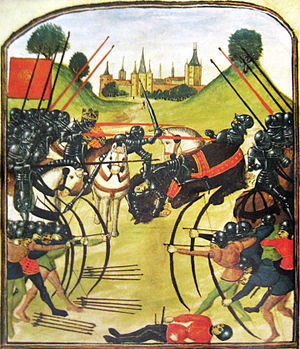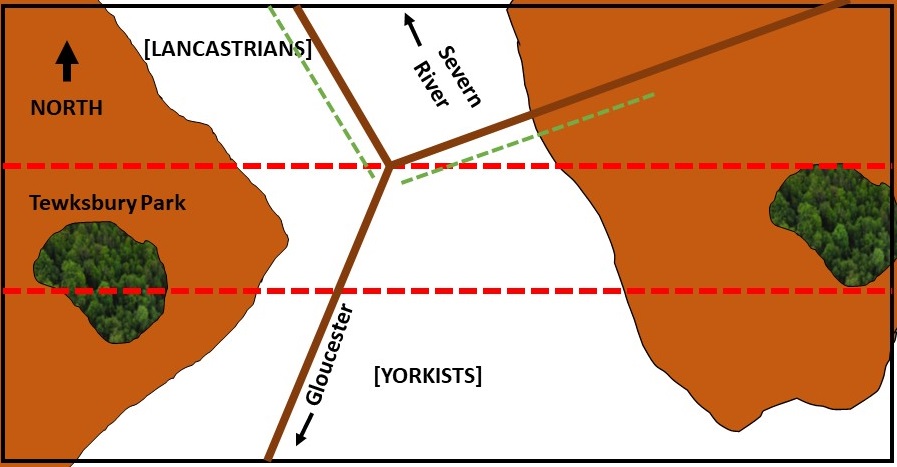Tewkesbury: The Fall of the House of Lancaster, May, 1471
A Scenario for A Bloody Dismal Fight

King Edward "displayed his bannars: dyd blowe up the trompets: commytted his caws and qwarell to Almyghty God, to owr most blessyd lady his mother: Vyrgyn Mary, the glorious Seint George, and all the saynts: and advaunced, directly upon his enemyes."
Background
Edward IV has re-asserted himself as the King of England, beating Warwick at Barnet after returning to England with the assistance of Charles of Burgundy. Warwick is slain. Henry IV - the current occupant of the throne - is dottering, and easily despatched. Meanwhile, Margaret of Anjou has landed with the support of King Louis XI of France, to join Warwick, and has raised an army in the West Country and Wales. King Edward IV marches rapidly out of London and pursues her north, where she attempts to escape across the Severn. At the top of his form, he outwits her, and at the prompting of her son, Edward, she turns to risk everything on a battle.
Margaret's Lancastrians deploy across the route north from Gloucester, near Tewkesbury Abbey, not far from where she had hoped to cross the river to safety. Her defensive position is a decent one, but during her flight she has had to abandon some of her artillery, which is cheerfully acquired and pressed into service by her enemies. This scenario is set just at the point where the Yorkists have advanced to give battle, and deployed in the lower ground in what would come to be known as the "Bloody Meadow."
This is a zero-sum situation: someone named Edward is going to die, while another will have the throne!
The Tabletop
The field is open ground, including the hills where they are not wooded. The woods are rough and provide cover. The dashed green line is a series of low walls and hedges which provide soft cover to troops immediately behind them.
Troops will set up anywhere within the zones provided, along the dotted lines. A distance of 18 inches separates the two armies - the battle begins within cannon range. Battles should be arranged on left, right, and center as indicated in the order of battle, but may be adjusted by players within those positions as they see fit.

Orders of Battle
Lancastrian
Duke of Somerset (Right Wing, Overall Commander) +1
Mounted Knights - 4 bases
Longbowmen - 3 bases
Billmen - 4 bases
Lord Wenlock/Prince Edward/Margaret of Anjou (Center)
Mounted Knights - 4 bases
Longbowmen - 3 bases
Bombards - 1 base
Irregulars - 4 bases
Earl of Devon (Left Wing)
Foot knights - 4 bases
Crossbowmen - 3 bases
Irregulars - 4 bases
Yorkist
Lord Hastings (Right Wing)
Foot Knights - 4 bases
Longbowmen - 3 bases
Irregulars - 4 bases (handgunners)
King Edward IV (Center, Overall Commander) +1
Mounted Knights - 4 bases
Crossbowmen - 3 bases
Bombards - 2 bases
Foot Knights - 4 bases
Richard, Duke of Gloucester (Left Wing)
Mounted Knights - 4 bases
Longbowmen - 3 bases
Irregulars - 4 bases (handgunners)
Special Rules and Victory Conditions
Historically, there was some fear of an ambush on the part of the Yorkists, and they deployed a mounted force in Tewkesbury Park to deny its use to the enemy. In this game, either of the woodlands may be used for this purpose by either side. Before play begins, unbeknownst to their opponents, each side may choose to deploy a unit in one or both of the woods on the flanks of the battle area. If both sides choose to deploy in such positions, the units will be revealed at the start of play, at a distance of 6 inches away from each other, within the feature, or optionally at its near edge. If only one side makes such a deployment in either feature, that unit will remain hidden until an enemy enters the feature, or they choose to make a visible action (moving or firing). These units fall under the command of the nearest battle commander (right or left, as appropriate).
The game continues until one side or the other loses its Edward, or breaks its opponent. (Almost no notable Lancastrian personage survived this battle historically, with the exception of Margaret herself, who fled but then gave herself up - it was one of those "chopping-off-the-heads-of-the-defeated" kinds of affairs. (And the one Lancastrian leader who may have been in Yorkist pay, and conceivably could have survived defeat - Wenlock - was brained with a mace by an angry Somerset who accused him of throwing the battle. Lovely!)

